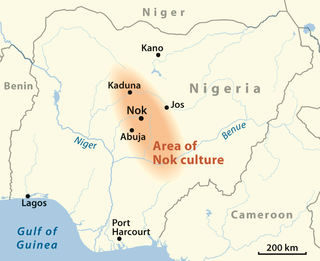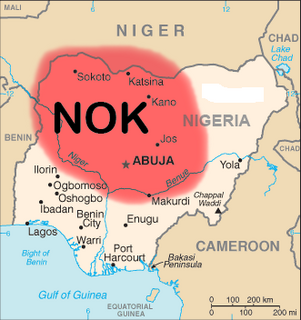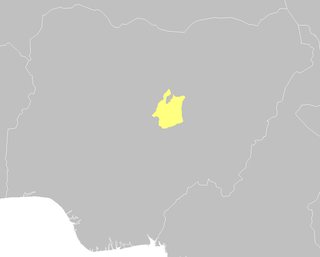The Chalcolithic, a name derived from the Greek: χαλκός khalkós, "copper" and from λίθος líthos, "stone" or Copper Age, also known as the Eneolithic or Aeneolithic is an archaeological period which researchers usually regard as part of the broader Neolithic. In the context of Eastern Europe, archaeologists often prefer the term "Eneolithic" to "Chalcolithic" or other alternatives.
The Iron Age is the final epoch of the three-age division of the prehistory and protohistory of humanity. It was preceded by the Stone Age and the Bronze Age. The concept has been mostly applied to Europe and the Ancient Near East, and, by analogy, also to other parts of the Old World.
The history of Nigeria can be traced to prehistoric settlers (Nigerians) living in the area as early as 1100 BC. Numerous ancient African civilizations settled in the region that is today Nigeria, such as the Kingdom of Nri, the Benin Empire, and the Oyo Empire. Islam reached Nigeria through the Borno Empire between and Hausa States around during the 11th century, . while Christianity came to Nigeria in the 15th century through Augustinian and Capuchin monks from Portugal. The Songhai Empire also occupied part of the region.

African art describes the modern and historical paintings, sculptures, installations, and other visual culture from native or indigenous Africans and the African continent. The definition may also include the art of the African diasporas, such as African American, Caribbean or art in South American societies inspired by African traditions. Despite this diversity, there are unifying artistic themes present, when considering the totality of the visual culture from the continent of Africa.

Africa has the longest record of human habitation in the world. The first hominins emerged 6-7 million years ago, and among the earliest anatomically modern human skulls found so far were discovered at Omo Kibish, Jebel Irhoud, and Florisbad.

A bloomery is a type of furnace once used widely for smelting iron from its oxides. The bloomery was the earliest form of smelter capable of smelting iron. A bloomery's product is a porous mass of iron and slag called a bloom. This mix of slag and iron in the bloom, termed sponge iron, is usually consolidated and further forged into wrought iron. The bloomery has now largely been superseded by the blast furnace, which produces pig iron.

Most African sculpture was historically in wood and other organic materials that have not survived from earlier than at most a few centuries ago; older pottery figures are found from a number of areas. Masks are important elements in the art of many peoples, along with human figures, often highly stylized. There is a vast variety of styles, often varying within the same context of origin depending on the use of the object, but wide regional trends are apparent; sculpture is most common among "groups of settled cultivators in the areas drained by the Niger and Congo rivers" in West Africa. Direct images of African deities are relatively infrequent, but masks in particular are or were often made for traditional African religious ceremonies; today many are made for tourists as "airport art". African masks were an influence on European Modernist art, which was inspired by their lack of concern for naturalistic depiction.

Ferrous metallurgy is the metallurgy of iron and its alloys. It began far back in prehistory. The earliest surviving iron artifacts, from the 4th millennium BC in Egypt, were made from meteoritic iron-nickel. It is not known when or where the smelting of iron from ores began, but by the end of the 2nd millennium BC iron was being produced from iron ores from Sub-Saharan Africa to China. The use of wrought iron was known by the 1st millennium BC, and its spread marked the Iron Age. During the medieval period, means were found in Europe of producing wrought iron from cast iron using finery forges. For all these processes, charcoal was required as fuel.

The Sao civilisation flourished in Central Africa from ca. the sixth century BC to as late as the sixteenth century AD. The Sao lived by the Chari River Around Lake Chad in territory that later became part of Cameroon and Chad. They are the earliest people to have left clear traces of their presence in the territory of modern Cameroon. Sometime around the 16th century, conversion to Islam changed the cultural identity of the former Sao. Today, several ethnic groups of northern Cameroon and southern Chad, but particularly the Sara, Kotoko, claim descent from the civilization of the Sao.
Long before 1500 much of modern-Nigeria was divided into states identified with contemporary ethnic groups. These early states included the Igbo Kingdom of Nri, the Benin Kingdom, Yoruba kingdoms, the Hausa cities, and Nupe. Additionally numerous small states to the west and south of Lake Chad were absorbed or displaced in the course of the expansion of Kanem, which was centered to the northeast of Lake Chad. Bornu, initially the western province of Kanem, became independent in the late 14th century. Other states probably existed but the absence of archaeological data prevents accurate dating. In the south, the earliest Kingdom was the Igbo Kingdom of Nri which emerged
Early Nigerian history relates to the period of history in Nigeria prior to the common era. Recent archaeological research has shown that people were already living in Isarun, Nigeria as early as 11,000 BC and perhaps earlier at Ugwuelle-Uturu (Okigwe) in south-eastern Nigeria. Microlithic and ceramic industries were developed by savanna pastoralists from at least the 4th millennium BC and were continued by subsequent agricultural communities. The Efik/Ibibio/Annang people of single ancestor of the coastal southeastern Nigeria are known to have lived in the area several thousands of years before Christ.
The topic of early iron metallurgy in sub-Saharan Africa encompasses both studies of the technology and archaeology of indigenous iron production, and also an understanding of the role that iron production played in African societies before European colonization.

Katsina-Ala is a Local Government Area (LGA) of Benue State, Nigeria. Its headquarters are in the town of Katsina-Ala where the A344 highway starts. It is also the location of an important archeological site where artifacts of the Nok culture have been found.
Copper metallurgy in Africa encompasses the study of copper production across the continent and an understanding of how it influenced aspects of African archaeology.

Taruga is an archeological site in Nigeria famous for the artifacts of the Nok culture that have been discovered there, some dating to 600 BC, and for evidence of very early iron working. The site is 60 km southeast of Abuja, in the Middle Belt.
Samun Dukiya is an archeological site in Nigeria in the Nok valley where artifacts from the Nok culture have been found, dating to between 300 BC and 100 BC.
The area currently known as the United Arab Emirates (UAE) was formerly populated by inhabitants of a number of coastal and inland settlements, with human remains pointing to a pattern of transmigration and settlement as far back as 125,000 years. Prehistoric settlement in the UAE spanned the Neolithic, with a number of distinctive eras of ancient settlement including the Stone Age Arabian Bifacial and Ubaid cultures from 5,000 to 3,100 BCE; the Hafeet period with its distinctive beehive shaped tombs and Jemdet Nasr pottery, from 3,200 to 2,600 BCE; the Umm Al Nar period from 2,600 to 2,000 BCE; the Wadi Suq Culture from 2,000–1,300 BCE and the three Iron Ages of the UAE.













